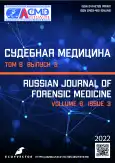Establishment of the fact and features of a substance barrier made of multilayer and combined materials transferRED by a firearm
- Authors: Kuzmina V.A.1, Pinchuk P.V.1,2, Leonov S.V.1,3, Suhareva M.A.3
-
Affiliations:
- Chief State Center for Forensic Medicine and Forensic Expertise 111
- The Russian National Research Medical University named after N.I. Pirogov
- Moscow State University of Medicine and Dentistry named after A.I. Evdokimov
- Issue: Vol 8, No 3 (2022)
- Pages: 29-35
- Section: Original study articles
- URL: https://journals.rcsi.science/2411-8729/article/view/122458
- DOI: https://doi.org/10.17816/fm681
- ID: 122458
Cite item
Full Text
Abstract
BACKGROUND: Currently, issues of establishing the fact of a person wounded by a firearm through a specific type of obstacle or due to a ricochet, as well as the identification of the obstacle material, have not been practically studied.
AIMS: To establish the fact and features of materials of multilayer and combined barriers (triplex, combined barrier made of keremogranite and foam concrete) transferred by a firearm when fired with 5.45×39 cartridges from a special shortened Kalashnikov assault rifle
MATERIAL AND METHODS: Shots were fired through various types of obstacles using a biological simulator of the human body from a 5-m distance. All experiments were recorded using high-speed video shooting with a Sony RX0 video camera having a frequency of 1000 frames/s. Bullets and their fragments that are extracted from the bullet trap or biological target tissues, after appropriate processing, were examined using a Leica M125 microscope, a Hitachi FlexSem 1000 II scanning electron microscope, and a Bruker Quantax 80 energy dispersive X-ray spectrometer.
RESULTS: Light microscopy of the firearms that overcame the obstacle revealed the presence of a characteristic bullet deformation when it breaks through each type of the studied obstacle. Scanning electron microscopy (SEM) and energy dispersion analysis (EDX) revealed the presence of overlays of barrier particles in each case on the entire surface of both deformed bullets and fragments of their shells and cores.
CONCLUSION: The conducted experimental study revealed SEM/EDX as a reliable method to establish the fact of a gunshot wound of a person through a barrier of multilayer and combined materials.
Full Text
##article.viewOnOriginalSite##About the authors
Vera A. Kuzmina
Chief State Center for Forensic Medicine and Forensic Expertise 111
Email: kuzminava@yandex.ru
ORCID iD: 0000-0003-0694-673X
SPIN-code: 1167-4112
Russian Federation, Moscow
Pavel V. Pinchuk
Chief State Center for Forensic Medicine and Forensic Expertise 111; The Russian National Research Medical University named after N.I. Pirogov
Email: pinchuk1967@mail.ru
ORCID iD: 0000-0002-0223-2433
SPIN-code: 7357-3038
MD, Dr. Sci. (Med.), Associate Professor
Russian Federation, Moscow; MoscowSergey V. Leonov
Chief State Center for Forensic Medicine and Forensic Expertise 111; Moscow State University of Medicine and Dentistry named after A.I. Evdokimov
Author for correspondence.
Email: Sleonoff@inbox.ru
ORCID iD: 0000-0003-4228-8973
SPIN-code: 2326-2920
MD, Dr. Sci. (Med.), Professor
Russian Federation, Moscow; MoscowMarina A. Suhareva
Moscow State University of Medicine and Dentistry named after A.I. Evdokimov
Email: suha@yandex.ru
ORCID iD: 0000-0003-3422-6043
SPIN-code: 4692-0197
MD, Cand. Sci. (Med.)
Russian Federation, MoscowReferences
- Kalmykov KN. Forensic medical characteristics of the defeat by ordinary and special bullets of the 1943 model, which previously overcame the obstacle [dissertation]. Leningrad; 1961. 462 р. (In Russ).
- Isakov VD. On the issue of the interaction of a bullet with an obstacle. In: Current issues of the theory and practice of forensic medicine: Materials of the scientific and practical conference dedicated to the 40th anniversary of the lifting of the siege of Leningrad and the complete liberation of the Leningrad region from the German-fascist invaders. Leningrad; 1986. (In Russ).
- Gusentsov AO. Forensic diagnostics of entrance bullet gunshot injuries resulting from ricochet [dissertation abstract]. Minsk; 2013. 23 р. (In Russ).
- Gusentsov AO, Kil’diushov EM, Tumanov ЕV. The current state of forensic medical expertise and the experimental studies of the after-penetration guhshot wound. Forensic Medical Expertise. 2019;62(2):61–66. (In Russ). doi: 10.17116/sudmed20196202161
- Gusentsov AO, Kildyushov EM. A human body simulator as an input parameter of ballistic experiment. Forensic Medical Expertise. 2020;63(5):23–29. (In Russ). doi: 10.17116/sudmed20206305123
- Denisov AV, Tjurin MV, Sohranov MV, et al. Features of hitting live targets in the bullet ricochet zone when shooting at solid obstacles. Bulletin of the Russian military medical academy. 2014;(1):179–183. (In Russ).
- Mattijssen E, Pater K, Stoel R. Ricochet behavior on glass-critical ricochet angles, ricochet angles, and deflection angles. J Forensic Sci. 2016;61(6):1456–1460. doi: 10.1111/1556-4029.13201
- Thornton JI, Cashman PJ. The effect of tempered glass on bullet trajectory. J Forensic Sci. 1986;31(2):743–746.
- Kerkhoff W, Alberink I, Mattijssen EJ. An empirical study on the relation between the critical angle for bullet ricochet and the properties of wood. J Forensic Sci. 2015;60(3):605–610. doi: 10.1111/1556-4029.12738
- Vermeij E, Rijnders M, Pieper P, Hermsen R. Interaction of bullets with intermediate targets: material transfer and damage. Forensic Sci Int. 2012;223(1-3):125–135. doi: 10.1016/j.forsciint.2012.08.016
Supplementary files










